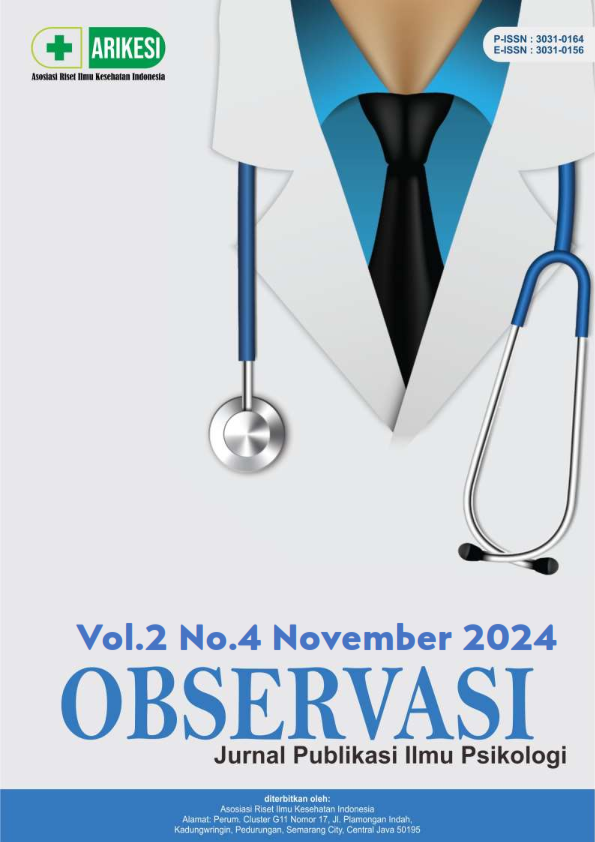Penerapan Terapi Psikoreligius : Dzikir pada Pasien Halusinasi Pendengaran di Rumah Sakit Jiwa Daerah (RSJD) Dr. Arif Zainudin Surakarta
DOI:
https://doi.org/10.61132/observasi.v2i4.623Keywords:
Hallucinations, Psychoreligious Dhikr TherapyAbstract
Hallucinations are a mental disorder in which clients experience disturbances in perception, sensory, taste, touch, sight or smell. Auditory hallucinations are where clients hear voices commanding and calling them to carry out activities in the form of two or more voices commenting on a person's behavior or thoughts. (Abdurakhman & Maulana, 2022). According to WHO (World Health Organization, 2020) there are 300 million people worldwide experiencing mental disorders such as depression, bipolar disorder, dementia, including 24 million people experiencing schizophrenia. Schizophrenia is one of the 15 major causes worldwide. APA data (American Psychiatric Association, 2020) states that 1% of the world's population suffers from schizophrenia. (Dwijayanti, 2022). In this study, the way to see the increase in the ability to control hallucinations is by using the AHRS scale which is used to measure auditory hallucination scores. To determine the results of applying dhikr psychoreligious therapy to patients with auditory hallucination disorders. Applying dhikr psychotherapy therapy using a descriptive case study method for 2 respondents for 2 years. consecutive days. The instrument used was the Auditory Hallucinations Rating Scale. Results: Based on the results of applying psychoreligious dhikr therapy to 2 respondents, there was a decrease in the symptoms of auditory hallucinations in patients. Psychoreligious dhikr therapy can be used as an implementation of independent nursing to control and overcome the emergence of hallucinations.
Downloads
References
Abdurakhman, R. N., & Maulana, M. azka. (2022). psikoreligius terhadap perubahan persepsi sensorik pada pasien halusinasi pendengaran di rsud arjawinangun kabupaten cirebon. Jurnal Education and Development Institut Pendidikan Tapanull Selatan, Vol. 11 No, 251–253.
Akbar, A., & Rahayu, D. A. (2021). Terapi Psikoreligius: Dzikir Pada Pasien Halusinasi Pendengaran. Ners Muda, 2(2), 66.
American Psychiatri Association. (2020). Practice guideline for the treatment of patients with schizophrenia. American psychiatric.
Andri, J., Febriawati, H., Panzilion, P., Sari, S. N., & Utama, D. A. (2019). Implementasi keperawatan dengan pengendalian diri klien halusinasi pada pasien skizofrenia. Jurnal Kesmas Asclepius, 1(2), 146-155.
Azizah, lilik ma’rifatul, Zainuri, I., & Akbar, A. (2020). Buku ajar kesehatan jiwa teori dan aplikasi praktik klinik (Hak Cipta). Yogyakarta: Idomedia pustaka.
Dinkes. Jatengprov. (2021). Profil Kesehatan Jawa tengah tahun 2021. Dwijayanti, kadek indah. (2022). Asuhan Keperawatan resiko perilaku kekerasan pada pasien skizofernia di wilayah kerja puskesmas sukawati I tahun 2022
Hernandi, B. (2020). Penerapan Aktivitas Terjadwal pada Klien dengan Gangguan Halusinasi di Wilayah Kerja Puskesmas Godean 1 (Doctoral dissertation, Poltekkes Kemenkes Yogyakarta).
Indra Maulana, Taty Hernawati, I. S. (2021). Pengaruh terapi aktivitas kelompok terhadap penurunan tingkat halusinasi pada pasien skizofrenia: literature review. 9(1), 153–160.
Oktaviani. (2020). Asuhan Keperawatan Jiwa Pada Tn.K dengan masalah Gangguan Persepsi Sensori : Halusinasi Pendengaran di Ruang Rokan Rumah Sakit Jiwa Tampan. http://repository.pkr.ac.id/id/eprint/498.
Pardede, J. A. (2022). Penerapan Terapi Generalis (SP 1-4) Pada Penderita Skizofrenia Dengan Masalah Halusinasi Di Ruang Sibual-buali: Studi Kasus.
Putri, N. N., Nainggolan, N. L. O., Saragih, S. V. M., Novia, N., & Zega, A. (2022). Studi Kasus: Asuhan Keperawatan Jiwa Dengan Gangguan Persepsi Sensori: Halusinasi Pada Penderita Skizofrenia.
Riskesdas, (2019).Undang-Undang Republik Indonesia No 18 tahun 2014 tentang Kesehatan jiwa pasal 4 menyediakan penanganan mulai dari promosi, pencegahan, pengobatan, hingga rehabilitasi.
Saragih, S. V. M. (2022). Asuhan Keperawatan Jiwa Pada Ny. F Dengan Masalah Halusinasi Pendengaran Di Ruangan Cempaka: Studi Kasus.
Sari, R. S., Suyanti, T. S., & Wijaya, S. (2023). Asuhan Keperawatan Jiwa Pada Ny. M Dengan Gangguan Sensori Persepsi: Halusinasi Pendengaran Akibat Skizofrenia Schizoaffective Disorder Di Ruang Madrim RSJD dr. Amino Gondohutomo Provinsi Jawa Tengah. DIAGNOSA: Jurnal Ilmu Kesehatan dan Keperawatan, 1(4), 83-93.
Tim Pokja SDKI DPP PPNI. (2017). Standar Diagnosa Keperawatan Indonesia (1st ed). Jakarta Selatan: Dewan Pengurus Pusat PPNI. Tim Pokja SIKI DPP PPNI. (2018). Standar Intervensi Keperawatan Indonesia : Definisi dan Tindakan Keperawatan (1st ed.). Jakarta: Dewan Pengurus Pusat PPNI.
Tim Pokja SLKI DPP PPNI. (2019). Standar Luaran Keperawatan Indonesia: Definisi dan Kriteria Hasil Keperawatan (1st ed.). Jakarta: Dewan Pengurus Pusat PPNI.
Wihartati, W. (2011). relaksasi dzikir.
World Helath Organization. (2020). Monitoring health of the SDGs.
Downloads
Published
How to Cite
Issue
Section
License
Copyright (c) 2024 Observasi : Jurnal Publikasi Ilmu Psikologi

This work is licensed under a Creative Commons Attribution-ShareAlike 4.0 International License.





